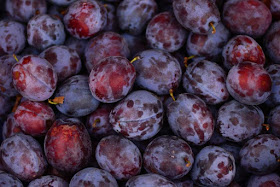A variety of plum called Damson will be used to make this spiced plum ketchup. It has purple or black skin, green flesh, and clingstone.
The skin of the damson plum can have a very tart flavor; particularly when unripe (the term "damson" is often used to describe red wines with rich yet acidic plumy flavors).
Damson plum is often used for cooking, and is commercially grown for preparation in fruit jam and other fruit preserves. Some varieties of damson, however, such as "Merryweather", are sweet enough to eat directly from the tree, and most are palatable raw if allowed to fully ripen. They can also be pickled and canned.
Preparation time: 20 minutes
Cooking time: 1 hour 10 minutes
Makes 1.5 liters
INGREDIENTS:
1.5 kg Damson plums, stoned and halved
500 ml white wine vinegar
4 small onions, peeled and roughly chopped
4 cloves of garlic, peeled and crushed
25 g fine sea salt
1 hot green chili, chopped (seeds left in)
2 bay leaves
1 strip of lemon rind
1 strip of orange rind
225 g demerara sugar
COOKING DIRECTIONS:
1) Put all the ingredients into a really large heavy-based saucepan or preserving pan and cook on a low heat, stirring occasionally, until the plums have softened. Turn up the heat to medium for about 20–25 minutes, then back down to a low heat for another 20–25 minutes.
2) Remove the bay leaves and the orange and lemon strips, and continue to cook until it thickens up a little (turning the heat up slightly if you need to). You will need to keep an eye on it, as it can catch and burn on the bottom, so stir often.
3) Leave the ketchup to cool for 10 minutes, then whiz it up with a stick blender – you can leave it chunky or whiz until smooth, it’s up to you.
4) Pour into a warm sterilized bottle or jars, and leave for about 2 weeks before using.
5) Refrigerate once opened.
Plum Nutrition Facts 100g
Plums are relatively low in calories, but contain a fair amount of important vitamins and minerals. One plum contains the following nutrients:
Raw plums are 87% water, 11% carbohydrates, 1% protein, and less than 1% fat.
In a 100 gram amount, raw plums supply 46 Calories and are a moderate source only of vitamin C (12% Daily Value), with no other nutrients in significant content.
Plum Cooking Tips- Is Plums Pits or Stone Seeds Bad for You?
Most chefs remove the fruit stones but others do not. The reason is to not to lose any of the pulp or because they believe the flavor is better. So they leave the stones in the final product.
A limited number of damson stones left in the plum ketchup are supposed to impart a subtle almond flavor. Just remember that all plums damson stones contain a toxin called cyagenic glycoside amygdalin.
REFERENCES:
Chris Bennett. 2015. Southeast Foraging: 120 Wild and Flavorful Edibles from Angelica to Wild Plums (Regional Foraging Series). Timber Press. ISBN-13: 978-1604694994
Justin Gellatly. 2014. Bread, Cake, Doughnut, Pudding: Sweet and Savoury Recipes from Britain's Best Baker. Penguin UK. ISBN-13: 978-0241146057
Romney Steele. 2011. Plum Gorgeous: Recipes and Memories from the Orchard, 1st Edition. Andrews McMeel Publishing. ISBN-10: 1449402402



No comments:
Post a Comment